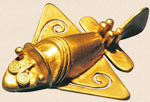
Golden Flyer Artifact (Fg. 1-8)
Modern researchers have mixed beliefs about the Quimbaya civilization, and their presumed knowledge of flight based on gold artifacts. There are arguments regarding this theory over the lack of building materials necessary to make flying machines hundreds of years ago along with the absence of modern engines, and that landing strips for the golden fliers have not been discovered. It's entirely possible for artifacts to be moved around from place to place in the ancient world, especially if they fell victim to a more dominate people, or the cultures migrated for survival over time. The artifacts do exist, and they might help clarify another interesting ancient phenomena not too far from where the Quimbaya once lived. Certain parts of the Nazca lines are believed by some researchers to resemble ancient runways. Quimbaya golden artworks were often buried with the dead as a token necessary for prosperity in the afterlife. Examining the cache of available artifacts it becomes evident the Quimbaya created artworks based on interpretations of real objects and people. The golden airplanes could be evidence of an ancient culture's knowledge of flight well before modern times - Or they could represent of an extinct species of insects.
There is also an alternative concept to consider with artifacts such as the Golden Flyer, be it through cultural influence from an outside civilization. Today we find a distinctly intriguing phenomena which takes place after a remote culture is visited for the first time with modern technology present. Isolated tribes visited in both Africa and South America by airplane have both demonstrated shifts in religious beliefs after the visit. One of the tribes welcomed the plane on its second visit with ceremonial fire and statues constructed in the shape of the airplane. Tribes people even went so far as to line themselves along a runway path to greet the visitors. If remote cultures exhibit this sort of behavior during the world's modern technological era, then likely the same concept has played out before. From this angle of thinking, theories then suggest the Quimbaya may have been influenced by another ancient culture, or perhaps, some sort of alien civilization.
http://www.mysterypile.com/quimbaya.php
Δεν υπάρχουν σχόλια:
Δημοσίευση σχολίου